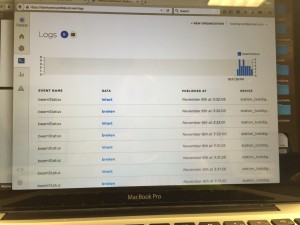Learning about drone and sensor journalism was very interesting and very new to me. I am so glad I had the opportunity to experience something that is still so fresh and new in journalism. Although drones are something that I thought I was pretty familiar with, I knew there was still a lot to learn about them.
I think that most interesting thing dealing with drones, besides being able to play with a $1200 drone, was Ben’s 360 degree camera idea. His video of the flood damage from Halloween weekend was amazing, and sparked so many ideas in my mind about how a 360 degree camera on a drone could affect journalism. By filming a video with that camera, the viewer is in control and is able to see what they want to. However, the drone was much louder than I had imagined, and I can understand the legality concerns with drones.
I wasn’t as familiar with the sensors as I was drones, but after working with them for a couple of hours, I can see how they are very useful for everyday life. My favorite part of the sensors workshop, was creating the motion sensor and seeing the information recorded in real time online.
I also enjoyed learning about how sensors work with security systems to turn on and off lights from a mobile device. With help from the particle app, we were able to control the brightness of our LED light through our phones. This is similar to services that allow people to turn on and off lights while not at home.
While searching the web for more about sensors, I came across an article about Tally robot – a robot designed to take inventory of store shelves and keep them fully stocked at all times (http://www.gizmag.com/tally-robot-autonomous-store/40334/). This technology would cut labor costs and avoid unhappy customers that aren’t able to find what they’re looking for. This robot is efficient and innovative. Tally Robot works with a set of sensors that take data from shelf inventory, identify misplaced items and collect data to notify store executives of consumer buying habits.

Tally Robot (image from http://www.gizmag.com/tally-robot-autonomous-store/40334/).
I believe the opportunities to use sensors are endless and will improve life of many people. Sensors can be used to monitor allergens or toxins in the air, humidity, temperature and many other things. I think sensors would be a great tool for anyone who wants to have a garden in their yard; the sensor can tell them how moist the soil is, how hot/cold the soil is, any toxins that could be affecting the growth of the plants or even notify the person if there are animals eating their plants.
However, Matt Waite discussed some issues with sensor journalism; “You’re talking about doing it with the cheapest software you can find; It’s not expertly calibrated. It’s not as sensitive as it possibly could be.” A simple mistake while building the hardware could affect the results collected, making them useless. Journalists would have to find a way to figure out whether sensor data was collected correctly. (http://radar.oreilly.com/2013/03/sensor-journalism-data-journalism.html)
Alyssa Phillips
